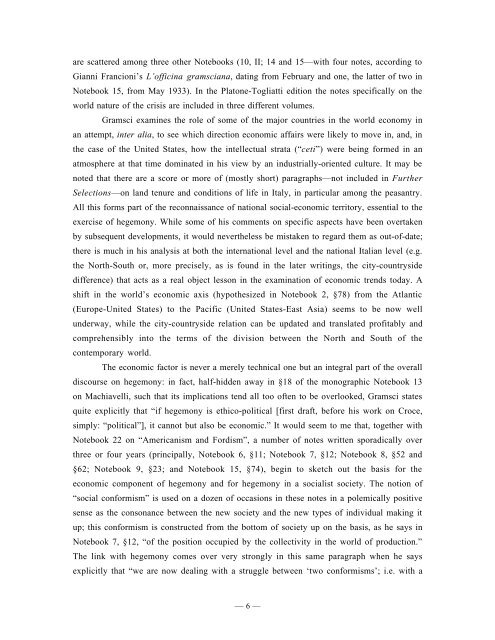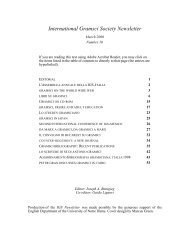Newsletter - International Gramsci Society
Newsletter - International Gramsci Society
Newsletter - International Gramsci Society
You also want an ePaper? Increase the reach of your titles
YUMPU automatically turns print PDFs into web optimized ePapers that Google loves.
are scattered among three other Notebooks (10, II; 14 and 15—with four notes, according to<br />
Gianni Francioni’s L’officina gramsciana, dating from February and one, the latter of two in<br />
Notebook 15, from May 1933). In the Platone-Togliatti edition the notes specifically on the<br />
world nature of the crisis are included in three different volumes.<br />
<strong>Gramsci</strong> examines the role of some of the major countries in the world economy in<br />
an attempt, inter alia, to see which direction economic affairs were likely to move in, and, in<br />
the case of the United States, how the intellectual strata (“ceti”) were being formed in an<br />
atmosphere at that time dominated in his view by an industrially-oriented culture. It may be<br />
noted that there are a score or more of (mostly short) paragraphs—not included in Further<br />
Selections—on land tenure and conditions of life in Italy, in particular among the peasantry.<br />
All this forms part of the reconnaissance of national social-economic territory, essential to the<br />
exercise of hegemony. While some of his comments on specific aspects have been overtaken<br />
by subsequent developments, it would nevertheless be mistaken to regard them as out-of-date;<br />
there is much in his analysis at both the international level and the national Italian level (e.g.<br />
the North-South or, more precisely, as is found in the later writings, the city-countryside<br />
difference) that acts as a real object lesson in the examination of economic trends today. A<br />
shift in the world’s economic axis (hypothesized in Notebook 2, §78) from the Atlantic<br />
(Europe-United States) to the Pacific (United States-East Asia) seems to be now well<br />
underway, while the city-countryside relation can be updated and translated profitably and<br />
comprehensibly into the terms of the division between the North and South of the<br />
contemporary world.<br />
The economic factor is never a merely technical one but an integral part of the overall<br />
discourse on hegemony: in fact, half-hidden away in §18 of the monographic Notebook 13<br />
on Machiavelli, such that its implications tend all too often to be overlooked, <strong>Gramsci</strong> states<br />
quite explicitly that “if hegemony is ethico-political [first draft, before his work on Croce,<br />
simply: “political”], it cannot but also be economic.” It would seem to me that, together with<br />
Notebook 22 on “Americanism and Fordism”, a number of notes written sporadically over<br />
three or four years (principally, Notebook 6, §11; Notebook 7, §12; Notebook 8, §52 and<br />
§62; Notebook 9, §23; and Notebook 15, §74), begin to sketch out the basis for the<br />
economic component of hegemony and for hegemony in a socialist society. The notion of<br />
“social conformism” is used on a dozen of occasions in these notes in a polemically positive<br />
sense as the consonance between the new society and the new types of individual making it<br />
up; this conformism is constructed from the bottom of society up on the basis, as he says in<br />
Notebook 7, §12, “of the position occupied by the collectivity in the world of production.”<br />
The link with hegemony comes over very strongly in this same paragraph when he says<br />
explicitly that “we are now dealing with a struggle between ‘two conformisms’; i.e. with a<br />
— 6 —



